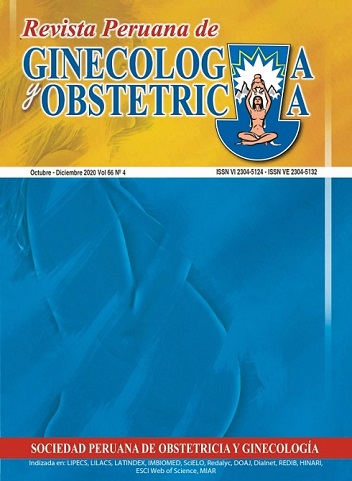Índice cefálico/abdominal/femoral (C+A-F), herramienta antropométrica efectiva en la evaluación del crecimiento fetal y de sus desviaciones
DOI:
https://doi.org/10.31403/rpgo.v66i2283Palabras clave:
Feto, Crecimiento fetal, Peso fetal, Peso al nacer, Biometría, Índice CAFResumen
Antecedentes. Lograr un método ideal que evalúe el potencial de crecimiento fetal es una aspiración incumplida en nuestra disciplina, e impone la necesidad de una evaluación individualizada, a través de nuevas herramientas y multiparámetros integrados. Objetivos. Evaluar la correlación y establecer valores de referencia del índice cefálico/abdominal/femoral (CAF) con la edad gestacional (EG) y el peso fetal estimado, para tipificar la evolución del crecimiento fetal como adecuado o no para la edad gestacional, y correlacionar con el peso del recién nacido a término. Pacientes y métodos. Se estudiaron 1 032 embarazos con embarazo simple y sin complicaciones, de 12 a 38 semanas de gestación, en el Centro Policlínico de Valencia, Venezuela, entre los años 2015 y 2017. Las medidas ecográficas y el peso fetal se estimaron a intervalos de 3 a 5 semanas. Los parámetros estudiados fueron circunferencia cefálica (CC), circunferencia abdominal (CA) y longitud del fémur (FL), integrados en la fórmula índice CAF = [(CC + CA) - FL]. Se aplicó el modelo de regresión cúbica y puntaje Z en 256 casos seguidos hasta el parto. Se establecieron tres grupos de CAF: a) CAF <50, b) CAF 50 a 57, y c) CAF ≥58, calculando la media ± desviación estándar de los pesos de los recién nacidos en cada grupo. Resultados. Según las semanas de gestación, el índice CAF reveló un R² = 0,96, p <0,05, mientras que para el peso fue R² = 0,92, p <0,05. En 256 casos seguidos hasta el parto, cuando el CAF tenía valor igual o superior a 58, el peso del recién nacido fue 3 361 ± 484 g, con diferencias estadísticamente significativas en relación al resto de grupos (prueba de student p <0,05). Conclusiones. El índice CAF es un método multiparméetrico que permite, a través de evaluaciones seriadas, determinar el potencial de crecimiento individual esperado y virtualmente también identificar sus desviaciones.Descargas
Descargas
Publicado
2020-12-03
Cómo citar
Sosa-Olavarría, A., Álvarez-Moya, E., Schenone Giugni, M. H., Pianigiani, E. C., Zurita-Peralta, J., & Schenone Giugni, C. V. (2020). Índice cefálico/abdominal/femoral (C+A-F), herramienta antropométrica efectiva en la evaluación del crecimiento fetal y de sus desviaciones. Revista Peruana De Ginecología Y Obstetricia, 66(4). https://doi.org/10.31403/rpgo.v66i2283
Número
Sección
Artículos Originales
















